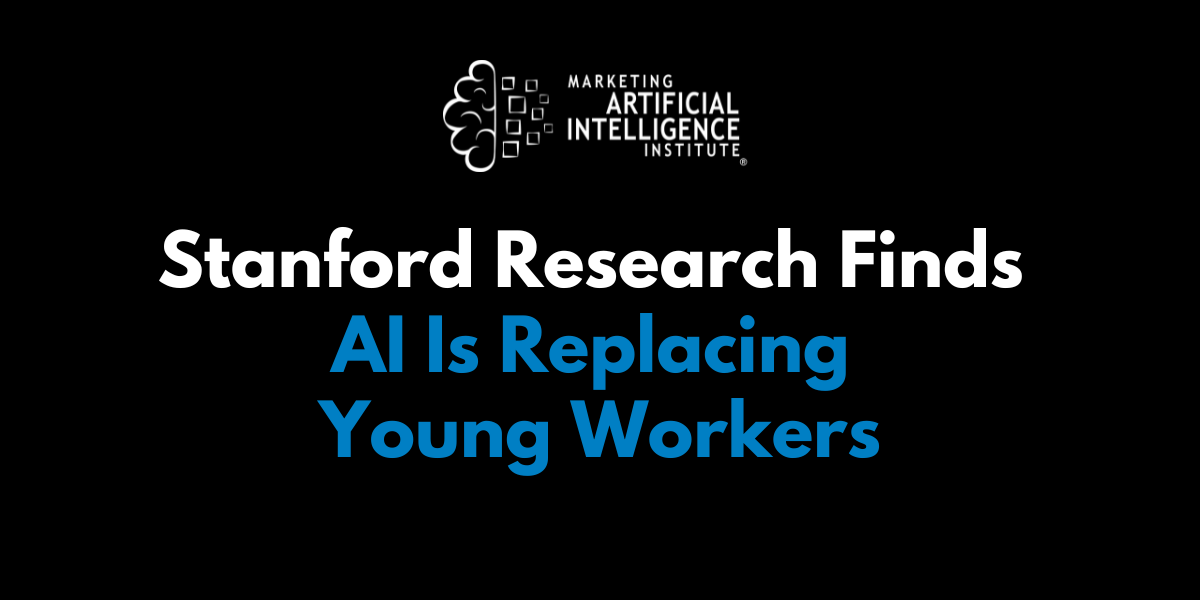New research out of Stanford just gave us one of the clearest signals yet that AI is beginning to transform the labor market, and younger workers are in the crosshairs.
On Episode 165 of The Artificial Intelligence Show, I dug into the research with SmarterX and Marketing AI Institute founder and CEO Paul Roetzer.
Here’s what you need to know.
A 16% Drop in Jobs for Young Workers
Stanford researchers Erik Brynjolfsson, Ruyu Chen, and Bharat Chandar analyzed payroll data from ADP, the largest provider in the US, spanning late 2022 (when ChatGPT launched) through mid-2025.
They focused on industries long identified as vulnerable to generative AI, such as customer service and software development.
The results were striking: employment among workers aged 22 to 25 in these sectors fell by 16%.
But that pain wasn’t shared across the board. More experienced employees in the same fields saw their opportunities hold steady, or even grow.
The researchers conclude that AI is displacing repetitive entry-level tasks, while helping seasoned workers accelerate and expand what they can do.
Methodology Matters
This wasn’t a casual glance at the job market. The Stanford team took pains to normalize the data and control for what they call “shock events” that might distort the picture.
They considered the lingering effects of the pandemic, the rise of hybrid work, and ongoing tech layoffs. Even after accounting for these factors, the AI signal remained clear.
“Employment has begun to decline for young workers in highly exposed occupations like coding and call centers,” Brynjolfsson summarized in a tweet. “But older workers and workers who use AI to augment, not automate work have seen job gains.”
My coauthor @econ_b provides the definitive thread summarizing our new paper with @RuyuChen about AI and the labor market.
— Erik Brynjolfsson (@erikbryn) August 26, 2025
TL:DR. Employment has begun to decline for young workers in highly exposed occupations like coding and call centers, but older workers and workers who use… https://t.co/Ylh8arXXjC
A Signal of Things to Come
The report is short, but it carries weight because it cuts through political spin. On one side, you have voices insisting that AI will massively disrupt jobs. On the other, some political figures and Silicon Valley leaders are publicly downplaying risks, especially with elections looming.
More neutral data, like Stanford’s payroll analysis, gives us a more grounded view. As Roetzer notes:
“They're literally just looking at payroll data and trying to find the trends because one side's saying, ‘Hey, we're gonna see a big disruption.’ And the other side's saying, ‘No, it's not going to happen and everything is going to be great.’”
Not to mention, it’s helpful to have actual data confirming what Roetzer is seeing in his work.
“Even last week I had conversations with some people at some pretty significant companies, and it's happening,” he says. “We are absolutely starting to see an impact on jobs. It’s not being talked about publicly, but it’s coming.”
Beyond Displacement: Policy and Preparation
So what should be done? Brynjolfsson has suggested adjusting tax policy so companies aren’t rewarded for replacing humans with machines. He also advocates for new benchmarks that measure how well AI collaborates with humans, what he calls “centaur” systems of humans and machines working together.
Others see demand growing for roles that involve managing and refining AI output. Meaning the future may be less about wholesale replacement and more about learning how to work with AI effectively.
Still, Brynjolfsson warns the disruption could spread beyond entry-level roles.
“What we need to do is create a dashboard early-warning system to help us track this in real time,” he told WIRED. “This is a very consequential technology.”
Finding the Signals in the Noise
The big takeaway?
This is an early signal, not the final word. And it doesn’t mean only entry-level jobs are at risk.
“I wouldn't take solace in this if I was middle management or a leader,” says Roetzer. “I still think middle management is going to get decimated, including the people who don’t have advanced domain expertise and can work with AI.”
For individuals, there’s a practical step you can take today.
JobsGPT, a tool built by Roetzer, lets you plug in your job title and see how exposed it is to AI disruption, based on an 11-level exposure analysis of model capabilities. It’s worth a look whether you’re just entering the workforce, in mid-career, or planning your child’s future.
Mike Kaput
As Chief Content Officer, Mike Kaput uses content marketing, marketing strategy, and marketing technology to grow and scale traffic, leads, and revenue for Marketing AI Institute. Mike is the co-author of Marketing Artificial Intelligence: AI, Marketing and the Future of Business (Matt Holt Books, 2022). See Mike's full bio.


